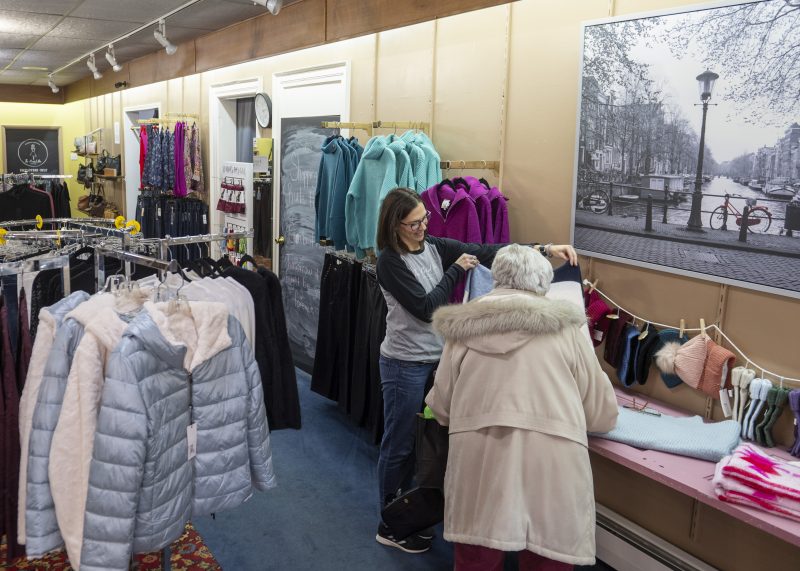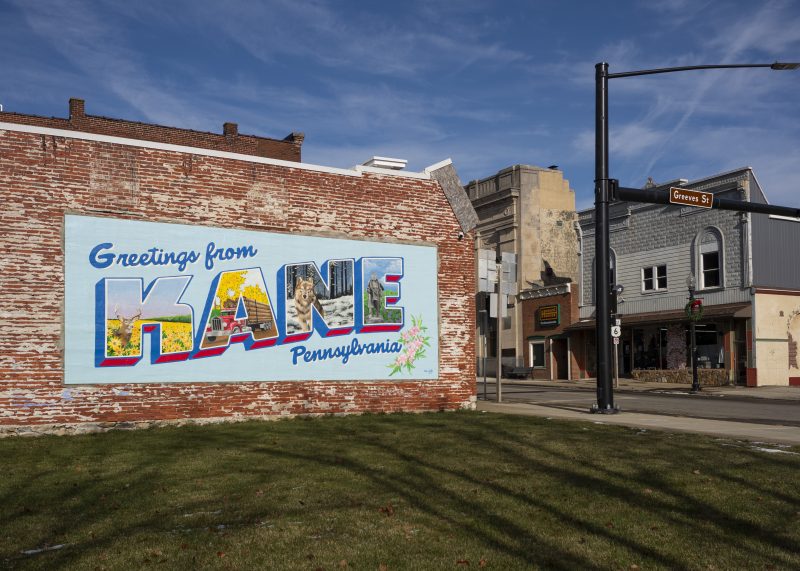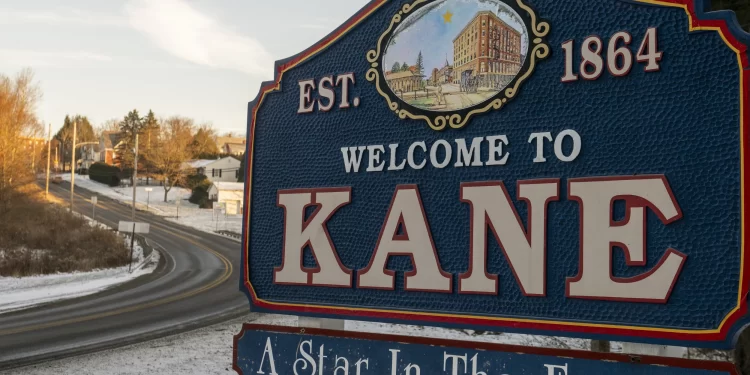Elected officials and community members in Kane have secured thousands of dollars to build an identity as a gateway to the Allegheny National Forest.
Marley Parish of Spotlight PA State College
This story was produced by the State College regional bureau of Spotlight PA, an independent, nonpartisan newsroom dedicated to investigative and public-service journalism for Pennsylvania. Sign up for our regional newsletter, Talk of the Town.
KANE — Years ago, when winds from a storm rolling through McKean County knocked down a tree on Pennsylvania Route 6, motorists didn’t wait for emergency services to clear the road.
A man grabbed a chainsaw from his truck and cut the tree into pieces. Then a group driving back to Kane from Warren County moved the pieces so traffic could pass.
Dressed in a business suit, Melanie Clabaugh helped haul wood that day.
Clabaugh told Spotlight PA she doubts the response would’ve been the same elsewhere, guessing most drivers would have waited for professionals to do the work.
That’s not what happens in Kane, she said.
“It’s people here,” Clabaugh said. “They work together to get things done in a way I haven’t seen in any other community.”
That spirit of the people in Kane, nicknamed “a star in the forest,” has also transformed the town into a destination for tourists and new residents after years of empty storefronts and deteriorating buildings.
Through local and state-level connections, elected officials and community members in Kane have created a place where people want to stay and move to, shaping the town into a gateway to the Allegheny National Forest.
A full-time executive director at the Kane Area Development Center, an umbrella organization for three local boards, the borough applying for additional grants, and a dedicated volunteer base have all contributed to the revitalization, securing funding for new projects while preserving local traditions.
Kate Kennedy, the development center’s director, said grants have played a key role in these efforts. They’ve supported facade improvements and marketing campaigns. The funding also goes toward community groups, which primarily rely on donations, membership fees, and volunteers.
The Pennsylvania Department of Community and Economic Development, which has allocated thousands of dollars in grant money to Kane over the years, thinks Kane’s “targeted approach” to development across local and regional groups has contributed to successful grant applications, spokesperson Penny Ickes told Spotlight PA. The area is also aided by “a heavy dose of community pride.”
“Kane has set a strong example for other small, rural towns — and even those that don’t fit that bill — to look at as an area setting success,” Ickes said.
Kane has a decadeslong history of people coming together to put ideas in motion, John Cleland, a retired judge who grew up in Kane, told Spotlight PA. That culture sets the community apart from other towns, he argued, recounting a story about how the mayor led local relief efforts for months after an EF4 tornado tore through the area in 1985.
“That doesn’t just happen. You don’t just create that,” Cleland said. “There has to be some group, traditions, and culture that create an environment that can help.”

Making revitalization possible
Julie Jackel remembers multiple clothing stores, a roller rink, and a five-and-dime from her childhood in Kane. Downtown was busy, and nearby factories were top employers in the 1980s.
After graduating from college in 1999, Jackel moved to Las Vegas and would come back over the holidays. Her husband, Thor, came with her to see family in 2012. By then, the town was “disappearing,” she told Spotlight PA.
Over the years, new businesses trickled into the area. Craft brewery Logyard Brewing, farm-to-table restaurant Table 105, and Lobo Fitness opened, and more new businesses were in the works.
When Julie and Thor Jackel visited in 2020, the change shocked them.

Now, the couple co-owns clothing boutique the Crooked Hem, which opened downtown in 2021. They’re also raising their kids in Kane and participating in the business community: Julie serves as a board member for the local chamber of commerce.
“I think that Kane works hard to make it a friendly place to open a business,” Kennedy said.
Local businesses participate in events where they stay open late to promote shopping small and run specials in collaboration with neighboring storefronts. Additionally, development groups have committed to making local buildings attractive for existing and new entrepreneurs.
To help with that, the Kane Area Revitalization Enterprise — also called K.A.R.E. — applied for a DCED grant to fund facade improvements and address blight. The group received $35,000 to give local storefronts a facelift.
In the past five years, K.A.R.E. has received more than $120,000 from DCED for revitalization. The organization’s budget is mostly equipped to handle administrative costs, staffing, and smaller events such as holiday carriage rides—so the outside funding allows it to pursue bigger projects.
She added that it seemed like each revitalization project created momentum for future efforts.
The Kane Area Industrial Development Corporation received $99,000 in federal dollars in 2020 to shore up a rural business incubator. The Appalachian Regional Commission, which gets public funding, also awarded a $5,000 grant for tourism promotion to the Kane Chamber of Commerce, which gets its budget from membership fees.

Kane hosted remote workers as part of a publicly funded program aimed at enticing participants to move to the Pennsylvania Wilds region. The initiative included grant funding to help administer the program and support a window wrap campaign. Private groups throughout north-central Pennsylvania have also awarded grants to groups in Kane to fund development and revitalization projects.
Kane doesn’t qualify for any special DCED designations — such as Main Street or Elm Street, which support long-term business growth and sustainability projects — that earmark it as a priority. However, the borough’s location in the PA Wilds made it eligible for the Route 6 Facade Program.
DCED uses its regional staff to build local connections, designating them as “liaisons” for community development efforts, Ickes said. The department also partners with other state agencies and nongovernment groups to push out available funding opportunities. Other state programs, such as Keystone Communities and Neighborhood Tax Credits, also aim to support smaller towns with revitalization.
Kane stands out to DCED for having residents dedicated to giving back to their community and an existing infrastructure that supports a full-time development role, Ickes said.
Kennedy’s executive director position has existed since the early 2000s, and she credits her predecessors for forming relationships with state officials, which have only strengthened with time.
Clabaugh, who previously served in the role and now serves on Kane Borough Council, said that project planning is more strategic now that Kane has experience applying for grants and carrying out projects. She called the executive director role “revolutionary” as a long-standing job in a small, rural town.
She added the role has strengthened relationships between community organizations, residents, and business owners.

Creating an ‘attractive’ place to live
Outside of public and private grant dollars, volunteers play a significant role in community projects, such as the annual “Kare for Kane,” a day when hundreds of residents do local beautification projects. Clabaugh started the tradition over a decade ago.
Several years ago, Kane officials were considering developing a strategic plan. Instead, community members organized an informal group — SPARKS — through which representatives from the borough council, the area school district, a local hospital, and others meet to discuss ways to make Kane a better place for residents.
Cleland said Kane didn’t want to focus on recruiting big industries to the area because the competition would be endless. Instead, they wanted to find ways to make the community “as attractive a place to live” for people already there.
“And if it’s attractive enough, people will choose to come here,” he said.
The group has no budget, no agenda at its monthly meetings, and no official power. However, it has fostered discussions about projects residents can work together to accomplish, such as building a deck on a nearby trail.
“All of a sudden, we got this collaboration put together in five minutes,” Cleland said. “It’s a very powerful model, which probably cannot be replicated anywhere else because of the traditions — that cooperation.”
The Evergreen Enchanted Playland, built by volunteers in 1988, is another testament to Kane’s passion for building things that last.
Kane Mayor Brandy Schimp’s mom chaired the fundraising committee for the initial construction, and she grew up playing on the playground after its completion. In 2019, residents including Schimp and her family helped restain the project. Many participants had connections to the playground that went back generations.
Making sure children had a place in the community is what Kennedy remembers about growing up in Kane. That’s what motivates her work now, and she hopes that shared dedication lives on so the next generation can continue the tradition in their hometown.
SUPPORT THIS JOURNALISM and help us reinvigorate local news in north-central Pennsylvania at spotlightpa.org/donate/statecollege. Spotlight PA is funded by foundations and readers like you who are committed to accountability and public-service journalism that gets results.



